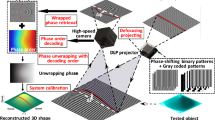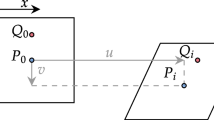Abstract
By using a passive autofocus system through a charge-coupled device (CCD) camera, this paper presents a new Yuan-Ze University (YZU) algorithm to detect the position of the sharpest image from a rough surface of an industry component quickly and accurately. To prove the performance of the YZU algorithm, it is compared to some well-known methods like fast Fourier transform (FFT), amplitude, Laplacian, discreet cosine transform (DCT), and conventional edge operators. Moreover, a new dynamic search method that implements this algorithm to produce real time digital image systems with fast response, accuracy, and robustness is proposed. The experiment results show that this technique is applicable to practical 3D measurement. In the application, two specimens a gauge block and an integrated circuit (IC) leadframe are tested to demonstrate the validity of 3D reconstruction from this YZU algorithm.
Similar content being viewed by others
References
Whitehouse DJ (1997) Surface metrology. Meas Sci Technol 8:972–995
Cho J, Cheng Q, Yu F,Yuanhao H (2004) Instantaneous velocity displacement and contour measurement by use of shadow moiré and temporal wavelet analysis. Appl Opt 43(21):4164-4171
Groot P, Deck L (1995) Surface profiling by analysis of white-light interferograms in the spatial frequency domain. J Mod Opt 42(2):389–401
Takeda M, Yamamoto H (1994) Fourier-transform speckle profilmetry: three-dimensional shape measurements of diffuse objects with large height steps and/or spatially surfaces. Appl Opt 33:7829–7837
Tenenbaum JM (1970) Accommodation in computer vision. Dissertation, Stanford University
Jarvis RA (1976) Focus optimization criteria for computer image processing. Microscope 24(2):163–180
Subbarao M, Choi TS (1995) Accurate recovery of three-dimensional shape from image focus. IEEE Trans Pattern Anal Mach Intell 17(3):266–274
Li Q, Feng H, Xu Z (2005) Auto-focus apparatus with digital signal processor. Proc SPIE, Adv Mater Dev Sens Imag II 5633:416–423
Watanabe M, Nayar SK (1996) Minimal operator set for passive depth from defocus. CVPR 96:431–438
Nayar SK, Nakagana Y (1994) Shape from focus. Proc IEEE Trans Pattern Anal Mach Intell 16(8):824–831
Geibler, Dierig T (1999) Handbook of computer vision and applications, vol 2, signal processing and pattern recognition, Kapitel: depth from focus. Academic, San Diego
Noubakhsh IR, Andre D, Tomasi C, Genesereth MR (1999) Mobile robot obstacle avoidance via depth from focus. Robot Autom Syst 22:151–158
Baina J, Dublet J (1995) Automatic focus and Iris control for video cameras. Proc Fifth International Conference on image processing and its application. Edinburgh, UK, pp 232–235
Schlag JF, Sanderson AC, Neumann CP, Wimberly, FC (1983) Implementation of automatic focusing algorithms for a computer vision system with camera control. Proc CMU Robotics Institute
Chern NK, Neow PA, Ang MH (2001) Practical issues inpixel-based autofocusing for machine vision. Proc IEEE International Conferenceon robotics and automation, Seoul, South Korea, May 2001,3:2791–2796
Noguchi M, Nayar SK (1994) Microscopic shape from focus using active illumination. Int Conf Pattern Recognit 147–152
Subbarao M, Choi T (1995) Accurate recovery of three dimensional shape from image focus. IEEE Trans Pattern Anal Mach Intell 17(3):266–274
Horn, BK (1968) Focusing, technical report AIM-160. Massachusetts Institute of Technology, May 1968
Davies ER (1990) Machinevision: theory, algorithms, practicalities. Academic, San Diego
Ryoo SM, Choi TS (2000)3-D profilometry by analysis of noisy white-light inferograms. Proc SPIE 3919:152–159
Author information
Authors and Affiliations
Corresponding author
Rights and permissions
About this article
Cite this article
Chen, CH., Feng, TL. Fast 3D shape recovery of a rough mechanical component from real time passive autofocus system. Int J Adv Manuf Technol 34, 944–957 (2007). https://doi.org/10.1007/s00170-006-0660-x
Received:
Accepted:
Published:
Issue Date:
DOI: https://doi.org/10.1007/s00170-006-0660-x




